Philips BX373A (1947)
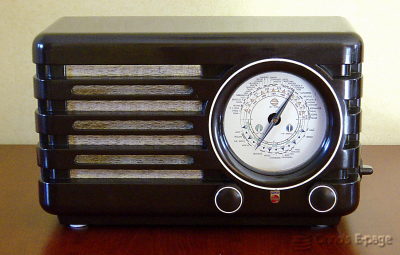

The BX373A is a standard uncomplicated superheterodyne receiver with 3 valves plus rectifier. Its valve line-up is:
I bought this radio on one of the NVHR swapmeets. It came relatively cheap because it was painted yellow all over. These radios are usually sold for around €100,-. The paint was some kind of wall paint or acrylic paint. The seller claimed the paint should be easy to remove because it was water based. He demonstrated that the paint came off easily in small flakes. On the good side was the very good shape the Bakelite case was in, it just needed a lot of polishing.
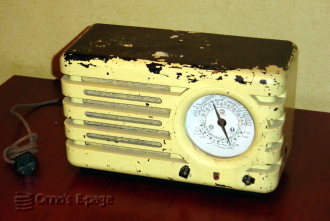
Case covered with yellow paint.
So at home, I first tried to clean the knobs. I put them in a bowl of water and left them overnight. The next day, most of the paint fell off just like that. I disassembled the radio and took the frame, the baffle and all other things out and put the case in the bath tub to soak for a night. Then after a firm scrub, I was able to remove almost all of the paint. Only on the bottom the paint did not want to come off. The "artist" who had painted the radio had tried some colors on the bottom and had sanded the bakelite to make the paint catch on. Fortunately, he hadn't sanded any of the rest of the case, so it shed off its coat of paint without any extra damage. I thoroughly polished it and it shone like a treasure.
Around the dial, there is a circle painted creamy white. This had vanished as a result of the scrubbing I had done. I used some acrylic paint, mixed with ocre, to make a fresh new circle.
The radio was a bit dirty when I bought it. The components turned out to be in good shape. I measured the leakage currents and it turned out that even the paper capacitors weren't too leaky. So I decided not to replace them, even coupling capacitor that usually wrecks the output valve.
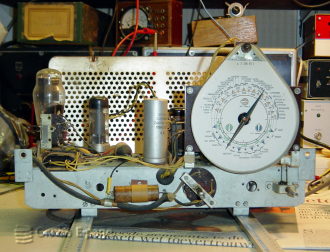
Chassis sitting on work bench.
Inspecting the power supply electrolytic, I suspected it was dried out. The safety valve on top (looks like a solder blob) had some white crystals around it. This means that the safety valve is leaking, causing the electrolytic to dry out. But when I reformed the electrolytic, they had a low leakage current, and its capacitance was ok. So I decided to leave it in order to conserve as much of the original parts as possible.
When I tried the radio, it gave some sound, but weakly. I replaced the IF valve and it became much better. Only now the radio squeaked. I tested the 100μF bypass capacitor in the negative voltage, and that one was all dried out. No capacitance. This electrolytic had an oiled paper cylinder as case, sealed at both ends with a compound looking like brown resin. I emptied it and hid a modern capacitor inside. After this, the radio played well, with an occasional crack. "I will have to monitor that closely", I said to myself.
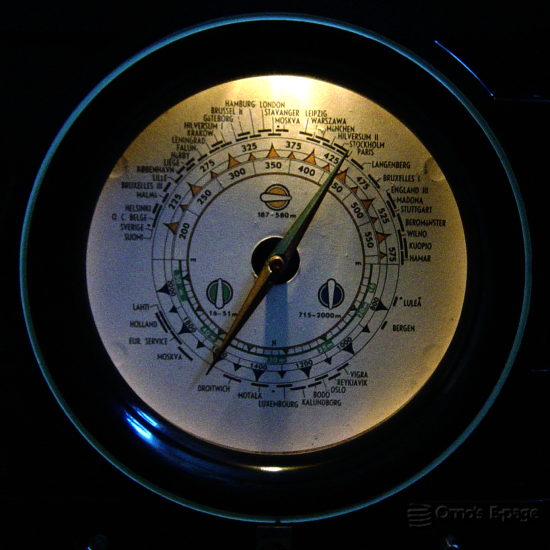
Dial is looking fantastic.
Only after a few occasions the BX373A started to crack a bit more, every now and then the volume dropped and the sound generally became awful. I suspected the coupling capacitor had started to leak and I decided not to use it any more before I had fixed it again.
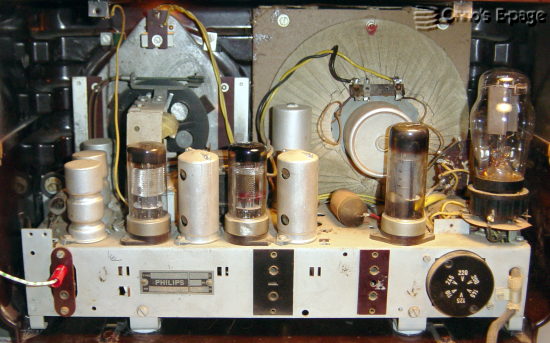
The inside, after repair.
The sound was better now, but it still faded and became distorted a few minutes after switching on. When I touched some points in the power supply, the sound became stronger to fade away again after a few minutes. Using a scope, I could not find any spurious oscillations linked to this behaviour. There was some IF signal on the output tube, but it was constant, seemed to be caused by some crosstalk from the detector sections of the EBL21. I started to suspect the output valve itself. The grid voltage went up slightly as the valve warmed up. I tried a few spare EBL21's and found one that functioned perfectly. So it was the output valve after all, and I seemed to have at least 5 bad EBL21's in my valve box.
Now my BX373A is working great and gives a steady and undistorted sound, much better than after the first repair. I hope it will stay that way. I will still have to monitor it closely.
Copyright © 2006 by Onno's E-page published 2006-02-26, last updated 2006-11-27